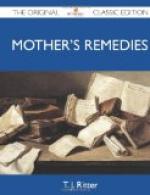At what age does it usually occur? Between six months and two and one-half years.
What are the causes of rickets? Improper food, or inability to absorb the food, unhygienic conditions. Nursing babies who have a healthy mother are not troubled with this disease unless she nurses too long into the second year. Starchy foods, too little milk or other animal food, taking the infant to the family table and allowing it to eat whatever it wants, these are the most common errors in baby feeding which very often result in rickets. Babies who are brought up on condensed milk, or other foods that contain little fat are likely to have rickets. Insufficient clothing, damp and badly ventilated buildings, a lack of out-door air and sunshine, and inherited constitutional weakness, are other causes.
When do the most marked symptoms usually occur? Between the sixth or fifteenth months.
What are the symptoms? Such children are likely to be nervous and irritable; child’s head sweats profusely at night, so much so that the pillows are very wet. The chest is poorly shaped and frequently has depressions at the sides, and little nodules or “beads” in the ribs where the ribs and breast-bone join. The child’s head is also peculiar. It is often very flat on the top and measures more around than a normal child at the same age. The forehead stands out and the sides and top are flattened. The soft spot in the skull is large and late in closing. He is late in cutting his teeth. His abdomen is generally large and prominent, pot belly; his muscles are soft and flabby, and his wrists and ankles are enlarged a little later. He takes cold easily. He is pale and anemic, although he may be plump and fat, and when he begins to walk his legs bend easily, and he will have bow-legs. When he sits, his back will look as if curved and this alarms his parents, who may think his spine is diseased.
Is such a disease curable? Yes, if taken in time; you can arrest its progress.
Do they ever die of rickets? Very seldom, but they do not stand other diseases very well.
[All about baby 615]
When and what shall I do for it? If you recognize the condition, have the baby attended to immediately by a physician. The food should be changed—such children require fats; very little starchy or sweet foods allowed. A baby ten to twelve months old can suck a piece of boiled bacon for a few minutes every day. Fruit juices can be given early, raw meat juice once a day. Give him his tub bath daily, and if he is apt to take cold easily he should have a little cold water dashed over his chest and spine, followed by a gentle brisk rubbing to start up the circulation. Sun baths are beneficial. Place the baby directly in the sun with his back to it, for an hour every day. Give him plenty of air and sunshine, both indoors and outdoors.
Medicine.—Cod liver oil is an excellent remedy with the hypophosphites. Cod liver oil alone with calcarea phosphoricum 3X (homeopathic) is splendid treatment also. The whole treatment must be continued for months—calcarea phos. four times daily.




